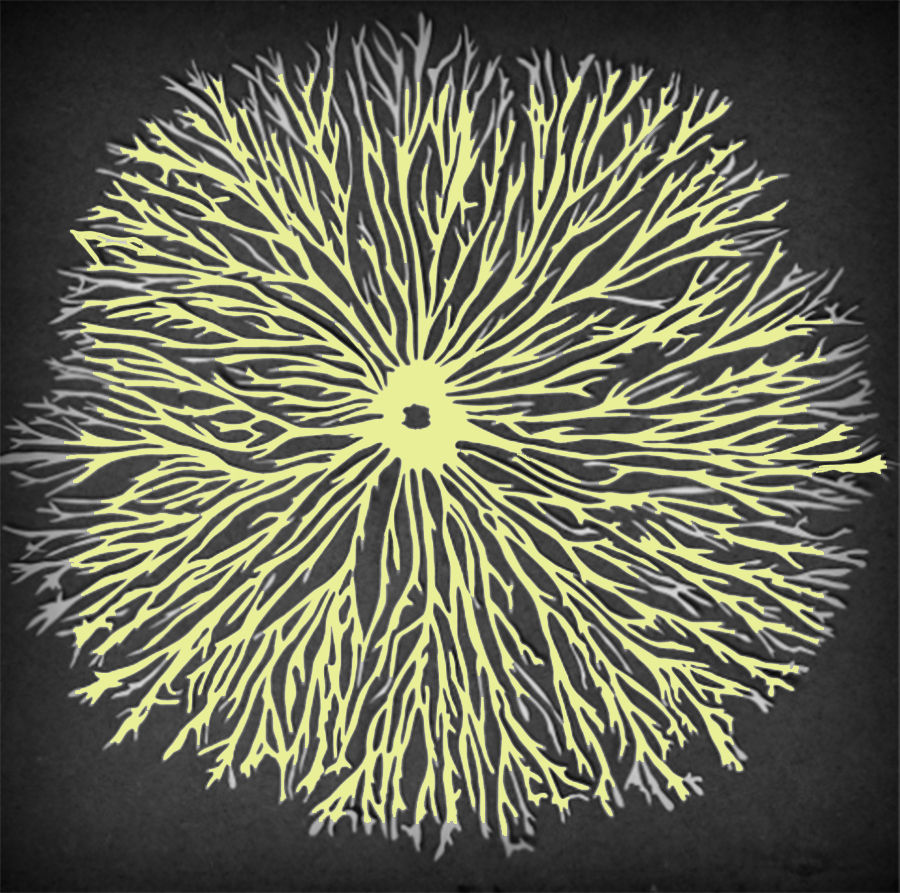
An important question!
And one we wish to answer.
Here we will present some of the most compelling information on the relationship between microdosing and creativity, based on the most recent research and knowledge.
While it’s widely known that various psychedelics are capable of inducing mind-expanding experiences and inspiring creativity and artistic creation, we would like to narrow our field of study to focus on whether or not microdosing in particular (and especially psilocybin microdosing) can help with creativity.
To state it bluntly right off the bat, there now exists both scientific and anecdotal evidence showing that microdosing psilocybin can enhance creativity, mental flexibility and problem solving.
But don’t take my word for it. Let’s dive in and examine the evidence.
We’ll begin by painting a broad picture with some anecdotal research.
As James Fadiman stated in regards to microdosing (before some of the research we will be discussing here was available), “One of the things you might have noticed is that there is no science yet- just world-wide use. Though there is something I call ‘citizen science,’ which is the thousands and thousands of people who have talked to each other and helped each other.”
Anecdotal evidence and personal accounts can be significant, enlightening, and useful in fields of study that might be considered grassroots, underground, nascent, counter-cultural, under-researched, or slightly taboo.
A global study (2020, Journal of Psychopharmacology) conducted by PhD students at York University and University of Toronto surveyed 6753 participants with microdosing experience (including psilocybin and LSD) within the last year.
They found that the most commonly reported benefits of microdosing were improved mood, enhanced creativity, and increased focus and energy.
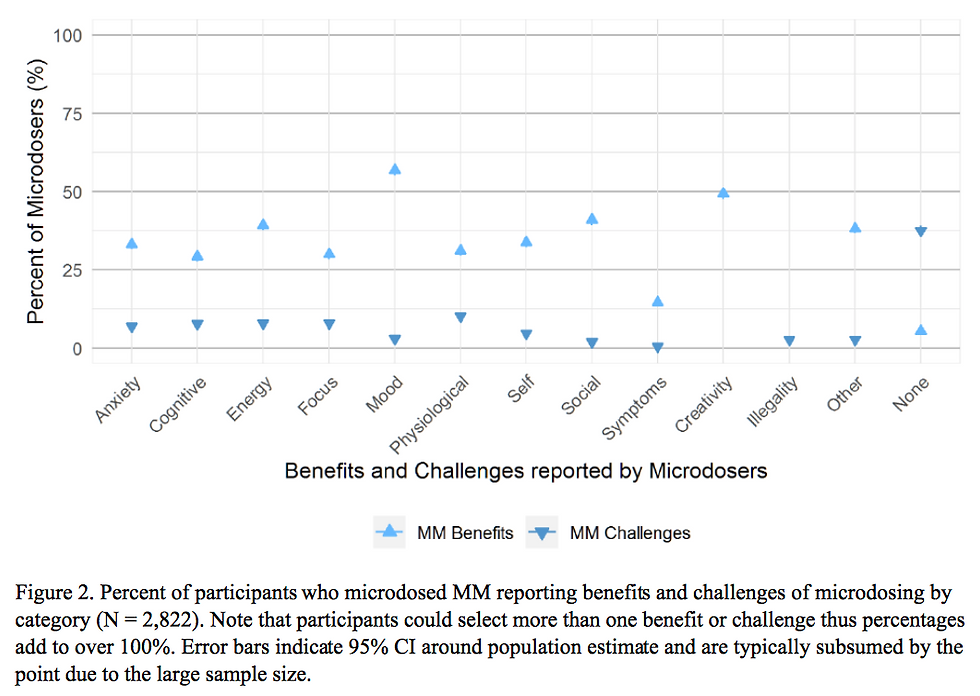
As you can see in the above graph, the most commonly reported benefits fell into the categories of Mood, Creativity, Social, and Energy, while the most commonly reported challenges were None, followed by Physiological.
The researchers concluded that while “double-blind, placebo-controlled experiments are still required to substantiate these reports, microdosing may have utility for a variety of uses while having minimal side-effects.”
Onwards! To research from James Fadiman- psychologist, author, and well-respected psychedelic researcher- who collected more than 1500 narrative reports through his microdosing website. After reviewing the reports and compiling the data, Fadiman found certain commonalities in people's experiences: people reported that microdosing effects them in subtle, but important ways, impacting how they move through their day, and helping them to feel lighter, more grateful, more observant, and more creative, among other effects.

Sticking with Fadiman, in the short microdosing chapter in his 2011 book, “The Psychedelic Explorer’s Guide” Fadiman included a number of anecdotes from various people who had experienced microdosing psilocybin.
One notable report came from a musician and composer who, after microdosing psilocybin, wrote, “The result was… a subtle but noticeable sharpness of mind and emotion. One of the results of this sharpness was that my guitar playing became more focused and agile… In conjunction with this sharpness I noticed a softening of the heart, which helped me connect to the emotion of the songs.”
Next, a professional artist’s model reported, “I found that I was much more emotionally even and more able to see the world as interrelated rather than disjointed. It was a fully pleasurable experience.”
And a professional musician and surfer reported, “I took a small dose of mushrooms and went out surfing. It was a life-changing event. I was so much more in my body and could feel deeper into it… But what was best was feeling like I connected back into the greater world.”
Fadiman concludes his short chapter on microdosing, writing, “Everyone said their experiences were positive and valuable… As several reports stated, someone taking a dose this low functions, as far as the world is concerned, a little better than normal. To date, I received no reports that sub-perceptual doses have caused any social disruption, personal upset, or any form of work-related difficulty… We may yet get to know more about what Albert Hofmann called ‘an under-researched area’” (Dr. Albert Hoffman, the inventor of LSD, was known to have used small doses of LSD for contemplative nature walks).
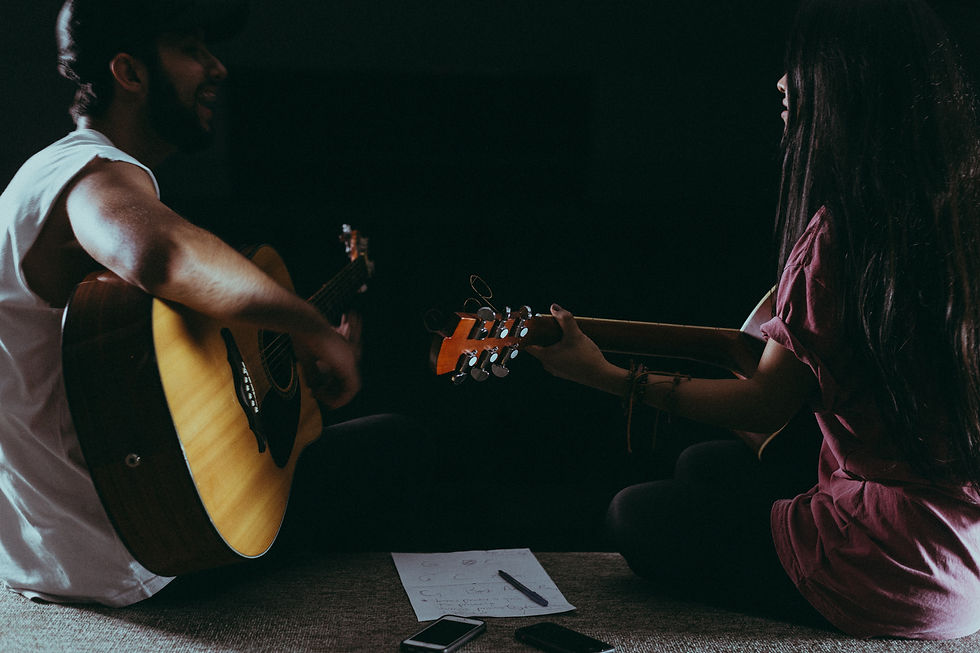
Another study, titled “Twenty percent better with 20 micrograms?” (2019, Harm Reduction Journal) provides a rich substrate of data and reports from a wide range of individuals with microdosing experience. The researchers from Karlstad University in Sweden qualitatively analyzed data collected from self-disclosure videos and comments across YouTube using specialized data collection software, and included participants who microdosed with both psilocybin and LSD.
Their findings suggest that microdosing can “provide a subtle but significant change in pschophysiological states, effectively serving as an all-purpose or nonspecific amplifier.” Specifically, the augmented states attributed to microdosing revolved around an expanding of time perception and an increased (wider) sense of “now presence.” Through being more present and grounded in the present moment, microdosers reported to experience less mental chatter and more focus, un-disrupted engagement (flow), and perceptual clarity.”
These findings are consistent with the findings of other studies, and are incredibly relevant to the area of creativity, as most artists will agree on the importance of “focus,” “flow,” and “perceptual clarity” to the creative process. If microdosing can be an aide that subtly, gently helps one enter these creative states of being, then it is clearly a creative tool that deserves further research and exploration.
Painters, musicians, dancers, and other artists may be interested to note the reported sensory enhancements: “The heightened sense of presence and perceptual clarity were said to qualitatively improve the experience of the present moment, both in the form of heightened visual acuity, increased awareness of sound, touch, smell, but also in the affective quality of the subjective experience.”
So, not only does microdosing help people by increasing their awareness of the present sensory experience, but it also heightens their emotional connection with that experience.

A few other commonly reported effects included enhanced mood, energy levels and drive, reduction in stress, sadness and anger, as well as increased patience, more openess, and a sense of groundedness and gratitude.
As far as more general performance enhancement, the most commonly reported benefits included increased access to creativity, enhanced productivity, and increased enjoyment of work.
Enhanced productivity and effectiveness were also reported in creative tasks like software development, music composition, academic work, and other mentally demanding tasks involving problem-solving.
Now, microdosing is beginning to sound like some sort of “magical” medicine… But it’s important to keep in mind that all of these reported benefits appear to overlap with the benefits one may experience by simply being more aware and open in the present moment. This is why the benefits of microdosing have been compared to the benefits of meditation- they both allow you to be aware and open in the present moment, less susceptible to distraction, and unconstrained by thought patterns that constantly pull you into the past or future.
It is the author’s hypothesis that microdosing subtly nudges one toward a state of mind or presence that opens one up to all the possibilities and potentialities that exist for a creative individual in the present moment. Microdosing simply provides an access point. It's like a key that opens a door to the beauty and possibility of the present moment. Other available keys include, mindfulness, awareness, breathing, meditation, etc.
So, back to our original question: Can microdosing help with creativity?
It appears we’re gathering clues and making headway towards an answer.
But let’s continue with perhaps the most groundbreaking and significant microdosing research that currently exists, a recent academic study that focused specifically on psilocybin microdosing:
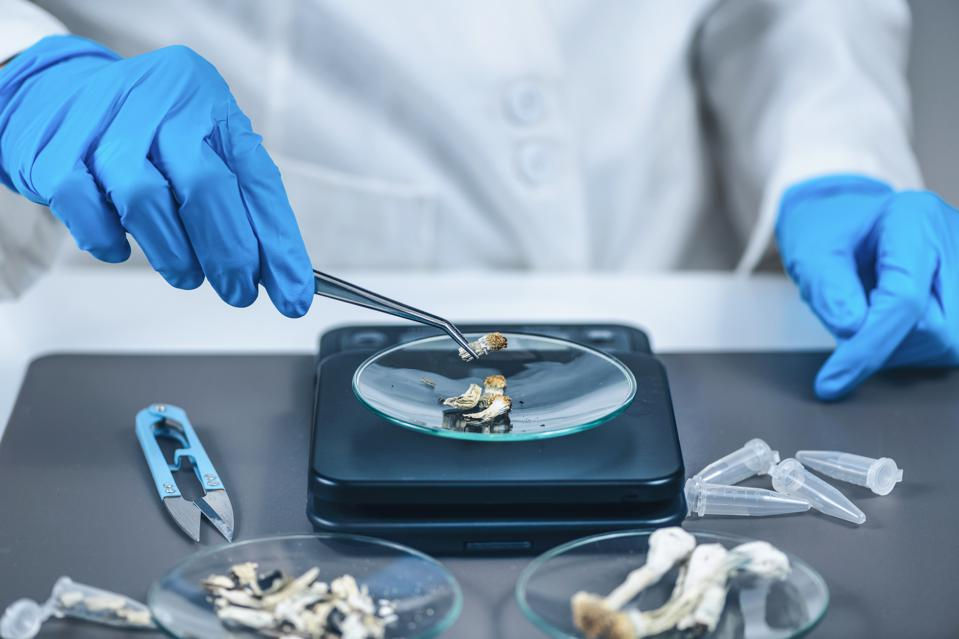
The first academic research into the effects of microdosing on creativity was performed at Leiden University in the Netherlands, headed by Luisa Prochazkova, titled, "Exploring the effect of microdosing psychedelics on creativity in an open-label natural setting" (2018, Psychopharmacology).
The study involved giving participants a series of tasks before and after consuming a psilocybin microdose. These tasks focused on essential aspects of creativity, including convergent thinking (ability to find a single solution to a problem), divergent thinking (ability to find many potential solutions to a problem), and fluid intelligence (ability to reason and solve novel problems).
Findings suggested that “the use of minute doses of psilocybin… could induce a state of unconstrained thought that may produce more new, creative ideas. Microdosing in this way may allow people to experience the creative benefits of psychedelics without the risk of so-called ‘bad trips’ that may come with higher doses.”
Prochazkova stated, “The results indicated that both convergent and divergent thinking performance was improved… We hypothesize that this is because microdosing induces cognitive flexibility and ultimately improves the repertoire of possible representations hence improving creativity.”
In other words, microdosing can increase one’s capacity to imagine and create without impeding the ability to think logically. Greater creativity with no loss of function.
Sounds like a potentially useful tool for artists, no?
Prochazkova goes on to state, “Large doses of psychedelics might induce an ultra-flexible mode of brain functioning and possibly a breakdown of control, while microdoses may be able to drive brain functioning towards an optimal balance between persistence and flexibility. Optimal balance in cognitive control would indicate why people are able to generate many ideas but also converge on a single correct solution.”
In other words, microdosing can increase one’s ability to consider multiple solutions while not impeding one’s ability to converge and focus on a single, ideal solution.
This groundbreaking psilocybin microdosing study represents the first academic research to quantitatively show that "microdosing psychedelics could improve creative performance," through inducing "a state of unconstrained thought."
The researchers finish by stating, “We hope this study will motivate future microdosing studies with more controlled designs to test this hypothesis.”
Great stuff!
So, can we now confidently say that there is a relationship between psilocybin microdosing and enhanced creativity?
Yes!
But...
...How does it work?
Well, let’s conclude this exploration by outlining the specific scientific mechanisms activated by psilocybin microdosing that researchers believe may enhance creativity as well as provide other benefits.
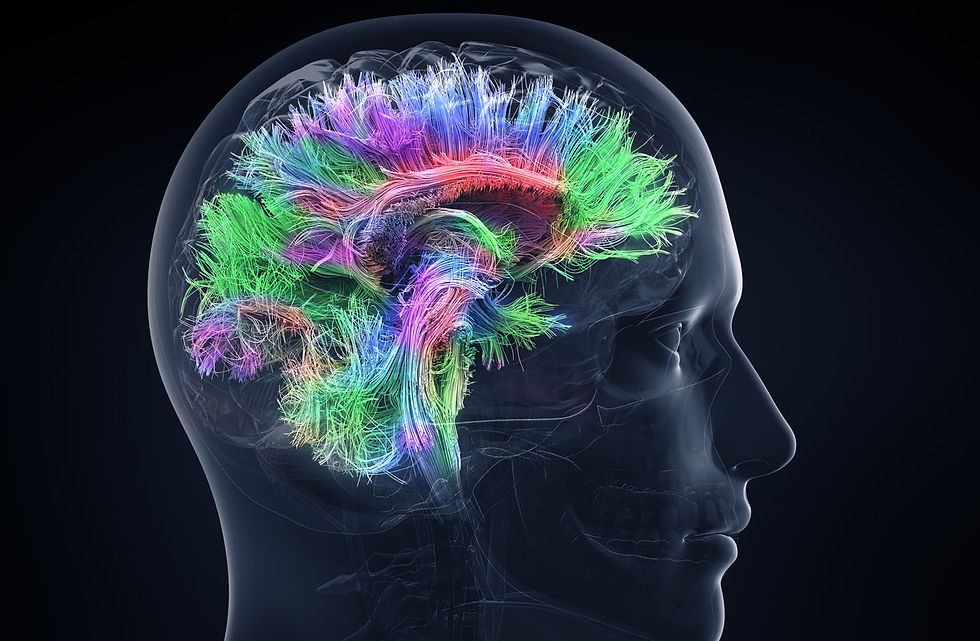
One way that psilocybin microdosing increases creative capacity is through psilocybin's ability to dampen the activity of an often over-used part of the brain called the Default Mode Network (DMN). The DMN is responsible for many mental activities, including day-dreaming, self-reflection, and ruminating about the past or the future.
Psilocybin switching off the DMN actually changes the connections between cortical regions and activates new modes, new sensations and thoughts, allowing us to “lose the inhibiting influence on one’s own narrative, which leads to insights that are kept from consciousness” (Carhart-Harris).
A second way psilocybin benefits creativity involves serotonin, one of the brain’s most important neurotransmitters. Serotonin affects nearly everything we do, from how we feel to how we process information. Psilocybin shares a similar structure to serotonin and mimics the chemical’s effects.
Psilocybin stimulates a serotonin receptor called 5-HT2A, which leads to two important results:
1) The production of Brain-Derived Neurotrophic Factor (BDNF), a protein that is "like Miracle-Gro for your brain." BDNF stimulates growth, connections and activity.
2) The increased transmission of Glutamate, a neurotransmitter responsible (in part) for important brain functions such as cognition, learning and memory.
The result is that psilocybin improves mental flexibility, and aids in breaking through rigid patterns of thought. Studies have displayed that 5-HT2A agonist activity correlates with an increase in associative learning and improvements in the ability to adapt behavior more flexibly.

So, what have we learned?
We’ve learned that on top of the mountains of anecdotal material that suggests a clear connection between psilocybin microdosing and enhanced creativity, there now also exists concrete, academic research that confirms these personal accounts and experiences by establishing the relationship between psilocybin microdosing and experiencing more flexible and less-constrained kinds of cognition. These findings act as a stepping stone, providing motivation and a foundation for further research into this relationship between psilocybin microdosing and creative capabilities.
Artists are explorers of the unseen world, explorers of the unconscious, explorers of human creative potential. When a tool emerges into cultural consciousness that apparently aids and enhances creative states of being and doing- with very minimal reported drawbacks or side-effects— it only seems logical that artists and creatives would be some of the first to bravely explore this fresh terrain and bring back their discoveries. And from the author’s personal experience and relationships with other artists and creatives, this playful experimentation and exploration of the world of microdosing, this learning for oneself and uncovering new possibilities, is exactly what is going on right now all over the world.
While more research is needed to continue to uncover and clarify the scientific mechanisms at play behind microdosing, to illuminate specific benefits, to establish microdosing best practices, and also to help in reducing the taboo around these substances by means of education and understanding, existing research has made it clear that the relationship between psilocybin microdosing and creativity is one that is fertile and worth exploring.
To all the creatives, artists and explorers out there, happy creating!
Read about a music composer's experience with psilocybin mushrooms and music: Musical Mushrooms: A Music Composer's Experience with Microdosing
References:
1. Microdosing psychedelics: Subjective benefits and challenges, substance testing behaviour, and the relevance of intention. Journal of Psychopharmacology, 2020.
2. James Fadiman's Microdosing Website: microdosingpsychedelics.com
3. Twenty percent better with 20 micrograms? A qualitative study of psychedelic microdosing self-rapports and discussions on YouTube. Harm Reduction Journal, 2019
4. Exploring the effect of microdosing psychedelics on creativity in an open label natural setting. Psychopharmacology, 2018.

Comentarios